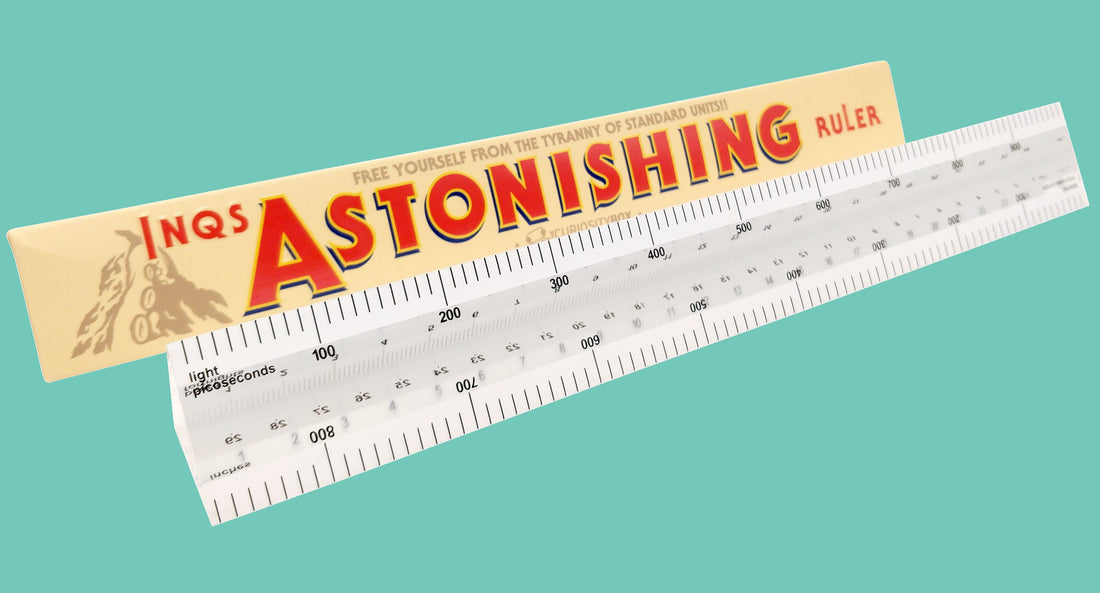Inq's Astonishing Ruler was a member-favorite from the Winter box. To make sure you don't miss any more of Inq's inventions, subscribe now.

We like to think of Inq's Astonishing Ruler as the most unusual rulers ever made. I mean, who else is gonna help you measure your living room in Everests? Or light picoseconds?
An interesting note: when we say “light picoseconds” or “sound microseconds,” did you know that those values vary depending on the material? The speed of light people commonly discuss is 299,792 kilometers a second–but that’s just the speed of light in a vacuum; the diffractive index of different materials means it travels at a different rate in other transparent things. In water, light drops down to about 225,000 kilometers a second, and if you could somehow find a diamond with a diameter of 125,000 kilometers, you’d see that in diamond, the speed of light drops by about 60%, it would barely go through that diamond in a second. And in 1999, scientists at Harvard found that light in a sodium atom slowed down to a measly 0.0.17 kilometers a second; about 38 miles per hour.
And sound? Well, “sound” is basically a vibration of kinetic energy passed from molecule to molecule. We usually encounter it in air, where the speed varies with almost anything that affects the physical properties of the gas: temperature, humidity, or altitude (which changes the air pressure). At sea level in air that’s 20° Celsius, sound travels at 343 meters a second. If you lower the temperature to 0°, it drops to 331.5 m/s, and if you bump it up to 40°C, then Mach 1 goes up to 355 m/s. But sound can travel though solid objects, too. In rubber, it’s a pokey 60 m/s, but if you’re listening through a giant piece of aluminum, sound will travel at around 6300 m/s. And if you go back to the gigantic diamond you used to slow down the speed of light? It will actually increase the speed of sound, all the way up to a staggering 12,000 meters a second. Just FYI, your ruler is using the speed of light in a vacuum, and the speed of sound in air at roughly room temperature.
Of course, there are a lot of units that we weren’t able to add to the ruler. Many people are familiar with the cubit, an obsolete unit used in the ancient world, roughly equal to the distance between the end of a forefinger and the elbow (fun fact: by the Viking age, the cubit has transformed into the Ell, a unit used for measuring cloth unit for measuring length of cloth, mentioned in the Icelandic Grágás law code; it fell out of use around 1200 BCE). And if you follow horse racing, you might have heard of the “hand” as a unit of equine measurement, abbreviated HH. For example Secretariat, perhaps the greatest racehorse of all time, was 16.2 HH. So how tall is that? About 64.8 inches, or 164.5 centimeters: a hand is equal to four inches, or 10.16 cm. The hand developed from the same type of measuring system as the cubit, where you would need to take measurements using body parts, and it was an edict of Henry VII that set it at four inches. In fact, there’s no agreed-upon historical reason why the hand is still used to measure horses. One possibility is that it was useful for farmers in the fields, who may not have had a measuring tool nearby. By the way, you may sometimes hear animals measured “to the shoulder”; a horse is technically measured “to the wither,” which is the highest nonmoving point on the shoulder.
A few more interesting measurements you may want to tick off on your ruler:
- 1.2 cm: one billionth of the diameter of the Earth
- 2.5 cm: distance the North American and Eurasian tectonic plates move apart from each other in one year
- 6 cm: one month’s growth of a blade of Kentucky bluegrass
- 20 cm: the length of a billion carbon atoms lined up end-to-end

